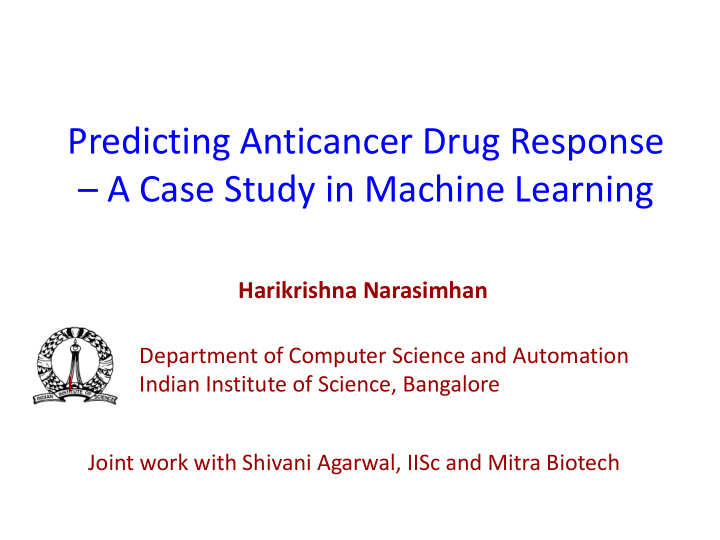



Predicting Anticancer Drug Response – A Case Study in Machine Learning Harikrishna Narasimhan Department of Computer Science and Automation I Indian Institute of Science, Bangalore Joint work with Shivani Agarwal, IISc and Mitra Biotech
An Example Machine Learning System Predictive Model
An Example Machine Learning System malignan gnant t Predictive or Model benign ? Patient X-ray with Lung Tumor
An Example Machine Learning System malignan gnant benign gn … benign gn
An Example Machine Learning System malignan gnant benign gn Machine Learning Predictive Algorithm Model … benign gn
An Example Machine Learning System malignan gnant benign gn Machine Learning Predictive Algorithm Model … benign gn
Predicting Anticancer Drug Response A Case Study Majumder, B., Baraneedharan, U., Thiyagarajan, S., Radhakrishnan, P., Narasimhan, H., Dhandapani, M., Brijwani, N., Pinto, D.D., Prasath, A., Shanthappa, B.U., Thayakumar, A., Surendran, R., Babu, G., Shenoy, A.M., Kuriakose, M.A., Bergthold, G., Horowitz, P., Loda, M., Beroukhim, R., Agarwal, S., Sengupta, S., Sundaram, M. and Majumder, P.K. Predicting clinical response to anticancer drugs using an ex vivo platform that captures tumor heterogeneity. Nature Communications . To appear.
CR PR NR Pre-dose Pre-dose Post-dose Post-dose Courtesy: Mitra Biotech
CR PR NR Pre-dose Pre-dose Post-dose Post-dose Complete Responder Courtesy: Mitra Biotech
CR PR NR Pre-dose Pre-dose Post-dose Post-dose Complete Responder Partial Responder Courtesy: Mitra Biotech
CR PR NR Pre-dose Pre-dose Post-dose Post-dose Complete Non- Responder Responder Partial Responder Courtesy: Mitra Biotech
Predicting Anticancer Drug Response Drug regimen 1 Drug regimen 2 Drug regimen 3 . . . . Drug regimen N
Predicting Anticancer Drug Response 100 Complete Response (CR) Drug regimen 1 Drug regimen 2 Drug regimen 3 . Partial . Response (PR) . . Drug regimen N No Response (NR) -100
Predicting Anticancer Drug Response an ex vivo platform for personalized cancer treatment Drug regimen 1 Drug regimen 2 Drug regimen 3 . . . . Drug regimen N
Predicting Anticancer Drug Response an ex vivo platform for personalized cancer treatment Drug regimen 1 Drug regimen 2 Drug regimen 3 . Tumor . Ecosystem . . Drug regimen N
Predicting Anticancer Drug Response an ex vivo platform for personalized cancer treatment Drug regimen Drug regimen 1 Drug regimen 2 Drug regimen 3 . Tumor . Ecosystem . . Drug regimen N
Predicting Anticancer Drug Response an ex vivo platform for personalized cancer treatment Drug regimen Drug regimen 1 Drug regimen 2 Drug regimen 3 . Tumor . Ecosystem . . Parameters Drug regimen N
Predicting Anticancer Drug Response an ex vivo platform for personalized cancer treatment Drug regimen Drug regimen 1 Drug regimen 2 Drug regimen 3 . Tumor Predict . Ecosystem response . . Parameters Drug regimen N
Predictive Model Drug regimen respond onder Predictive Tumor or or Ecosystem Model non on-resp espond onder? Parameters
Predictive Model Drug regimen respond onder Predictive Tumor or or Ecosystem Model non on-resp espond onder? Parameters: Viability Histology Proliferation Apoptosis
Predictive Model w 1 x Viability + w 2 x Histology + w 3 x Proliferation + w 4 x Apoptosis Drug regimen respond onder Predictive Tumor or or Ecosystem Model non on-resp espond onder? Parameters: Viability Histology Proliferation Apoptosis
Evaluating the predictive model predicted non-res esponder (NR) res esponder (R) non-res esponder (NR) actual res esponder (R)
Evaluating the predictive model predicted non-res esponder (NR) res esponder (R) non-res esponder (NR) True Negative actual res esponder (R) True Positive
Evaluating the predictive model predicted non-res esponder (NR) res esponder (R) non-res esponder (NR) True Negative False Positive actual res esponder (R) True Positive
Evaluating the predictive model predicted non-res esponder (NR) res esponder (R) non-res esponder (NR) True Negative False Positive actual res esponder (R) False Negative True Positive
Evaluating the predictive model predicted non-res esponder (NR) res esponder (R) non-res esponder (NR) True Negative False Positive actual res esponder (R) False Negative True Positive
Evaluating the predictive model predicted non-res esponder (NR) res esponder (R) non-res esponder (NR) True Negative False Positive actual res esponder (R) False Negative True Positive Goal: Maximize true positives! Keep false positives in an acceptable range!
Evaluating the predictive model
Evaluating the predictive model
Evaluating the predictive model
Evaluating the predictive model ROC curve 0.25
Evaluating the predictive model ROC curve good odness ness of of 0.25 mo model
SVMpAUC A New Machine Learning Method • Optimize performance in initial portion of the curve – Narasimhan H and Agarwal S, ICML 2013 – Narasimhan H and Agarwal S, KDD 2013 0.25
Experimental Results • 164 patients (109 training / 55 test) – Head-and-neck cancer (HNSCC) – Colorectal cancer (CRC)
Experimental Results • 164 patients (109 training / 55 test) – Head-and-neck cancer (HNSCC) – Colorectal cancer (CRC) • Results: 100% true positive rate @ 25% false positive rate
Experimental Results • 164 patients (109 training / 55 test) – Head-and-neck cancer (HNSCC) – Colorectal cancer (CRC) • Results: 100% true positive rate @ 25% false positive rate
Experimental Results • 164 patients (109 training / 55 test) – Head-and-neck cancer (HNSCC) – Colorectal cancer (CRC) • Results: 100% true positive rate @ 25% false positive rate • Gives higher true positive rate than baseline SVOR machine learning method
Experimental Results
Experimental Results
Experimental Results Colorectal Cancer (CRC)
Experimental Results Colorectal Cancer (CRC) Head and Neck Squamous Cell Carcinoma (HNSCC)
Acknowledgements • Pradip K. Majumder, Mitra Biotech, Bangalore • Biswanath Majumder, Mitra Biotech, Bangalore • Padhma Radhakrishnan, Mitra Biotech, Bangalore • Shiladitya Sengupta , Brigham and Women’s Hospital, Harvard Medical School, Boston,USA • Mallikarjun Sundaram, Mitra Biotech, Bangalore
Recommend
More recommend